Norwegian Road Tunnel Premieres AI-Based Incident Detection
There are well over 1,200 road tunnels in Norway. Camera-based incident detection is the preferred way to keep these tunnels safe and support tunnel operators in organizing fast incident response. Gradually introduced since the nineties, camera-based detection is now well established. Both visual and thermal imaging cameras have proven to be a fail-proof solution for 24/7 automatic incident detection inside tunnels. With the latest camera technology upgrade of the Damsgård Tunnel in Bergen, Norway is premiering AI-enhanced dual-vision cameras as a new evolution in incident detection.
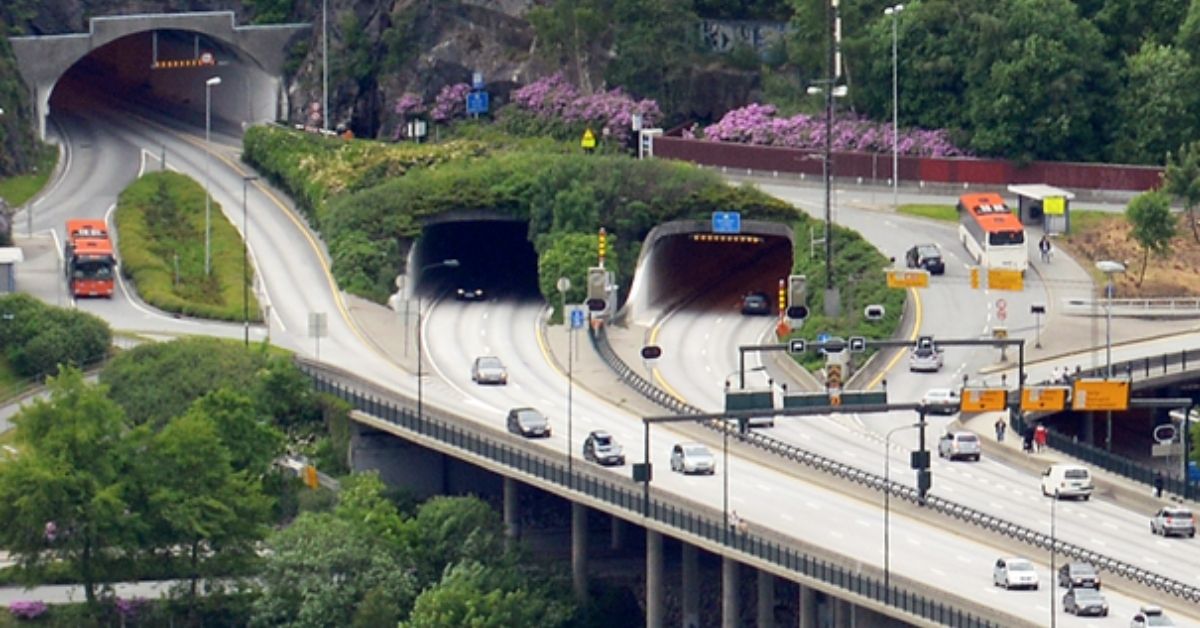
Damsgård Tunnel Technology Upgrade
The Damsgård Tunnel is part of Norwegian National Road 555, which runs from Fjell to the city center of Bergen. The road tunnel opened in 1992 and has two tubes of around 2.3 kilometers in length, each carrying two lanes of traffic through the Damsgårdsfjellet mountain.
In 2024, the tunnel will undergo a comprehensive technology upgrade, with the replacement of ventilation systems, lighting, drainage, and camera technology. Unique to this project is that—for the first time in Norway—AI-enhanced dual-vision cameras will be used. The traffic cameras from sensor specialist FLIR combine thermal and visual imaging technology in a ruggedized housing and rely on advanced deep learning algorithms that enable the camera to detect stopped vehicles, wrong-way drivers, queues, crossing pedestrians, and even smoke and fires in their early stages. Approximately 80 FLIR cameras are scheduled for installation the second half of the year.
The History of Tunnel Incident Detection in Norway
The Damsgård tunnel upgrade is another milestone in Norway’s long-standing efforts to secure the country’s vast number of tunnels. Due to Norway’s complex landscape, with fjords, mountains, and islands, road tunnels have always been a way to solve the region’s unique transportation challenges.
Norway has embraced the use of automatic incident detection in its road tunnels ever since the technology came into being, with FLIR setting the pace of this evolution since the beginning. In 1995, FLIR cameras were already used in the 1,500-meter-long Ekeberg Tunnel near Oslo. In August 1996, when a bus stopped and caught fire in that tunnel, the FLIR automatic incident detection system generated an alert to the tunnel operators, enabling them to close the tunnel entries and exits and activate warnings to oncoming motorists.
In 2004, a European directive on road tunnel safety1 prompted the roll-out of incident detection systems in tunnels continent-wide and since then the technology evolution has not stopped.
Visual and Thermal Incident Detection
Initially, visual CCTV cameras were used to detect incidents. The technology enabled first response teams to be deployed minutes—even seconds—after an incident or an irregularity (a fallen object, a pedestrian, a car slowing down) was detected.
About ten years ago, FLIR introduced thermal incident detection cameras in tunnels. Today, these cameras are established as critical assets that guarantee operators accurate detection throughout the tunnel infrastructure. The use of thermal imaging cameras has especially proven valuable for tunnel entrances and exits. There, shadows or direct sunlight can obstruct the view of visible-light cameras and therefore disturb traffic detection. Because thermal cameras detect heat, not light, they have no issues with these phenomena. As a result, thermal cameras can detect traffic 24/7 and in all weather conditions.

Visual vs thermal cameras: thermal cameras have proven to be unbeatable in detecting incidents in complete darkness.
One of the biggest advantages of thermal cameras in the field of tunnel safety is that they can effectively see through smoke. This makes them the ideal technology for tunnel safety operators or emergency response teams to find their way through a smoke-filled tunnel or for incident detection systems to spot issues in time. FLIR thermal cameras can also spot fires at the stage of ignition, making them the fastest and most reliable technology for fire detection inside road tunnels.
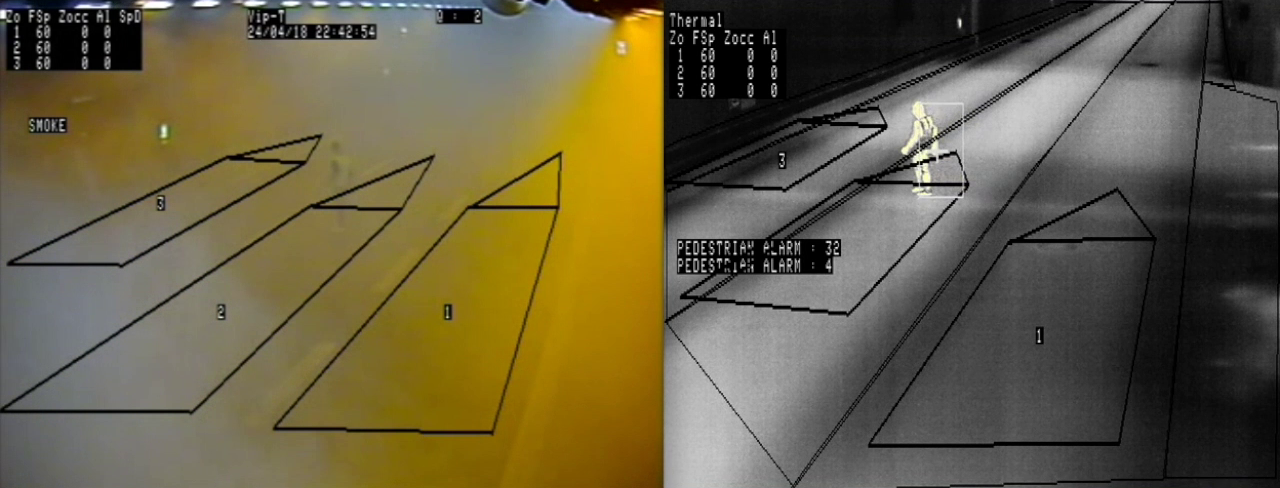
Thermal cameras allow operators to see through smoke, making it possible to detect vehicles and pedestrians in smoke-filled tunnels.
The Role of Dual-Vision Cameras
Both visual and thermal cameras have their merits. A visual camera may provide operators with more detail to assess the nature of an incident, while thermal cameras have proven to be unbeatable in detecting incidents in complete darkness and in challenging weather conditions. Today, both detection technologies can be combined into one system, hereby offering operators a more comprehensive view of the environment and improved accuracy compared to single-sensor systems. FLIR’s TrafiBot Dual AI camera is an example of such a combined system.
In 2018, FLIR’s ITS-Series Dual AID cameras were installed at the entrance and exit of the Lyderhorn Tunnel near Bergen. In 2021, technology integrator Trafsys also installed 332 of FLIR’s dual-vision cameras in the Hundvåg and Eiganes tunnels, which are part of the extensive Ryfast project. The cameras’ fire detection functionality proved effective when a car fire occurred in the Hundvåg tunnel in July 2020; the FLIR ITS dual thermal AID camera detected the fire within 7 seconds of visible flames, following an initial alert for a stopped vehicle and pedestrians.
Learn more: Keeping Norwegian Tunnels Safe with Automatic Incident Detection

The FLIR TrafiBot Dual AI cameras detect stopped vehicles, sudden speed drops, wrong-way drivers, pedestrians, fallen objects, and fires.
Artificial Intelligence in Incident Detection
FLIR’s TrafiBot Dual AI—installed in the above-mentioned Damsgård Tunnel—announces a new wave of incident detection cameras. The camera also combines a visual and a thermal camera in one unit, but what makes it stand out is the use of artificial intelligence and deep learning. AI algorithms embedded in the FLIR camera analyze captured images in real-time and in full resolution. This latest addition to FLIR’s portfolio of AI cameras is setting a new standard for automatic incident detection in tunnels, generating extremely accurate traffic data, incident detection information, and live track data.
Of course, analytics on traffic cameras are not new. Early cameras from decades ago already used some form of AI. So, what’s the difference with this new generation of AI cameras?
Much has to do with how detection systems analyze video images. Early generations of smart cameras analyzed the variation of gray levels in groups of pixels in successive video frames. When a vehicle enters a detection zone, the pixel value within that zone changes, and a detection is activated. Today’s AI systems, however, look at the entire camera image and use object detection techniques to analyze the traffic scene. This results in much better presence detection, better classification of traffic users, and the ability to determine position, speed, and direction. These new AI systems can handle more complex traffic situations and they are much better at making smart predictions.
It’s not hard to see where this is coming from. Over the past decades, computing speeds have increased, hardware prices dropped, and the exponential growth of data has worked as fuel for making AI better and more efficient. Instead of rule-based analytics—if x happens, then y—data-based systems are now in the lead. These systems can be trained on large datasets of images and learn how to identify and classify objects in an image. They use this knowledge to make decisions based on new images that they have never seen before.
Benefits of AI-Based Detection Systems
AI-powered detection systems are much more accurate than their non-AI alternatives. For tunnel operators, this is a big deal. Nothing is a bigger nuisance for control room operators than having to pay attention to continuous unwanted alarms. AI can help to filter out unwanted alarms by distinguishing between routine activity, weather phenomena, and actual incidents.
As an important aspect of their accuracy, AI-based systems are much more successful in detecting different vehicle classes. Detectors from FLIR will easily distinguish between a car and a van, or between a small and a large truck. It’s even possible to train a system to detect specific objects or incidents. And because cameras are so smart, installers nowadays are more flexible in installing their equipment. Even in less ideal camera positions, the detection performance of AI-based systems is high.
FLIR’s AI detectors can also predict vehicles trajectories. Based on vehicle parameters such as speed and direction, they can easily see where a car is going, even if for part of that trajectory the view on that car is occluded by a passing truck. This makes detection much faster and more accurate. Operators can even be warned by so-called pre-alarms for cars that are slowing down and likely to cause a collision.
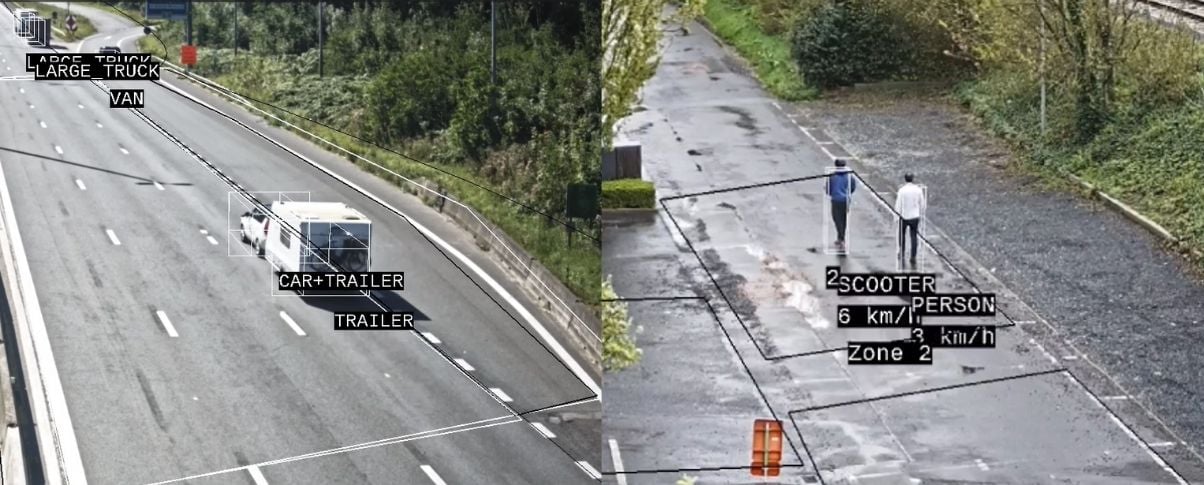
FLIR’s AI-based AID system will accurately classify a vast amount of vehicles, including less common classes such as the “trailer” and “E-scooter”.
FLIR’s AI detectors can also predict vehicles trajectories. Based on vehicle parameters such as speed and direction, they can easily see where a car is going, even if for part of that trajectory the view on that car is occluded by a passing truck. This makes detection much faster and more accurate. Operators can even be warned by so-called pre-alarms for cars that are slowing down and likely to cause a collision.
For traffic or security operators, AI offers many benefits. Since incidents can be detected much faster and with more accuracy, operators will be able to make better informed decisions, especially in high-stress situations, and they will be able to deploy emergency teams more quickly. AI will also reduce the need for constant human monitoring, allowing operators to focus on other tasks.
AI will benefit traffic planners too. Data collected from a camera can be analyzed over time to identify trends, patterns, or areas with a higher potential of incidents. This can be valuable for proactive traffic planning, infrastructure improvements, or for overall risk management.
Data as the Cornerstone of AI Performance
AI-based detection systems will become the norm very swiftly. Since these systems depend on massive data sets, it’s easy to understand that the detection performance will soon be determined by the quality of the data it is trained with. High-performance systems will need a lot of data for training—in our case video images of traffic—but not just any data that has been plucked from the internet will do.
Some camera manufacturers rely on publicly available datasets to train their AI systems. The problem with that approach is that, more often than not, these datasets are limited or of low quality. For example, internet data sets hardly have any thermal images, traffic images are mostly collected during sunny weather or friendly daytime conditions, and they are often taken from useless angles.
AI-based products from FLIR, on the other hand, are trained on datasets that have been collected in-house, in a time span of more than 30 years, with data samples that are relevant for practically any traffic scene you can think of. What’s more, FLIR’s datasets are continuously growing and with it the quality of its models and predictions. For FLIR, data is the true quality mark which stands for high-performance, accurate traffic detection.
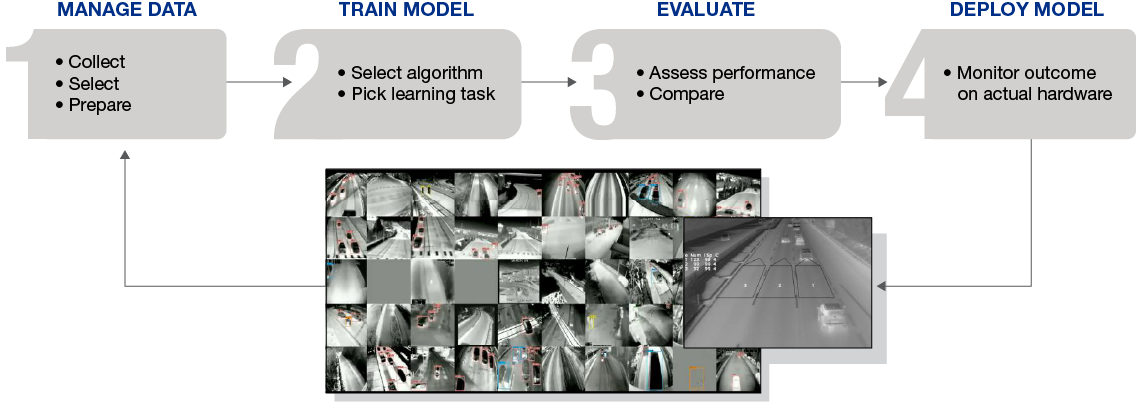
FLIR’s datasets are continuously growing and with it the quality of its models and predictions.
The Future is AI
Norway and FLIR share an interesting history of evolving incident detection technology. A lot has changed since the installation of the first FLIR automatic incident detection system in the Ekeberg tunnel in 1995. Today, incident detection systems combine multiple sensors—visual and thermal—and, most importantly, they use AI, which enables them to improve their detection performance over time with every new video image they process. It’s clear that artificial intelligence has a promising future in incident detection. Norwegian tunnels, and the average daily traffic of 40,000 vehicles in the Damsgård Tunnel, will only benefit from it.
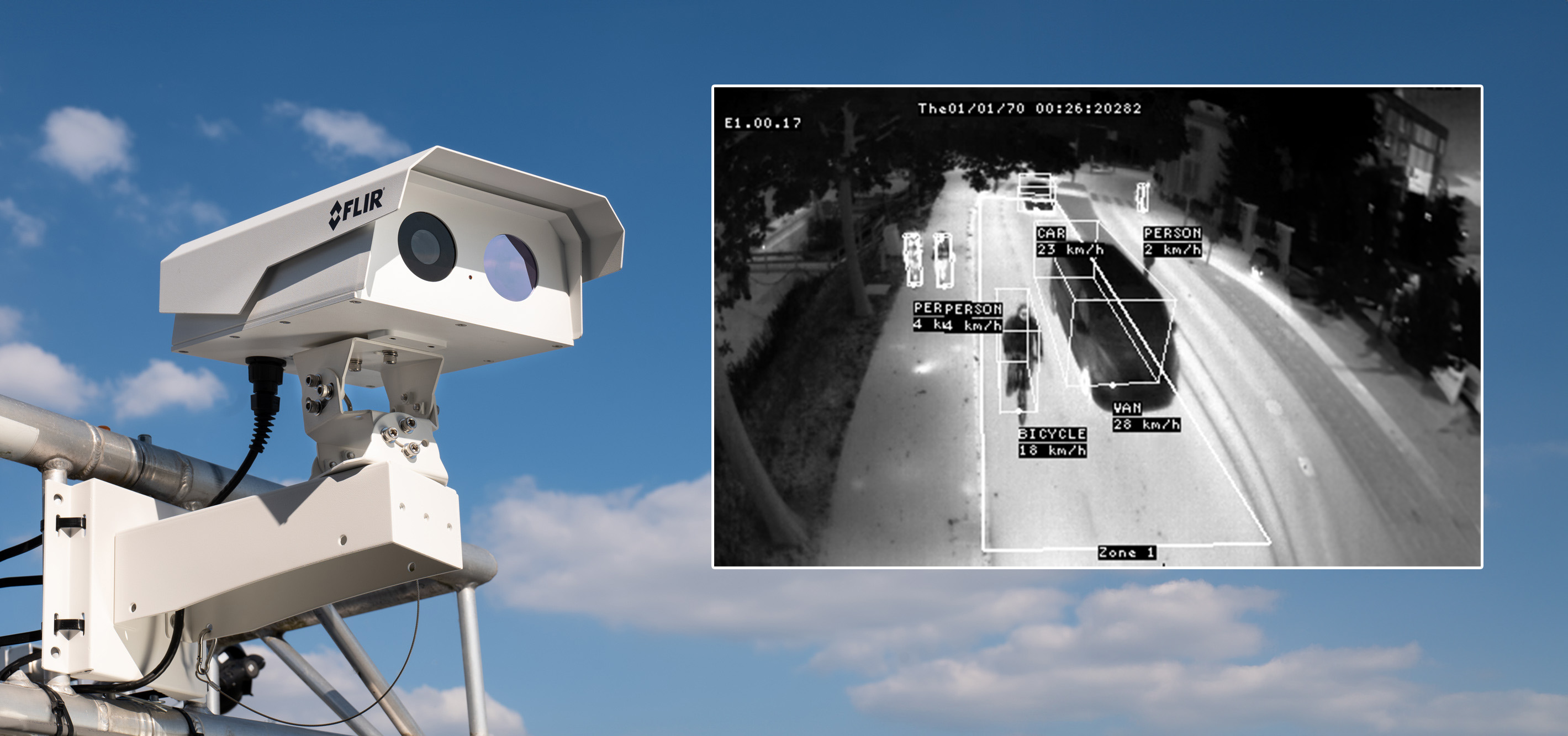
FLIR TrafiBot Dual AI cameras enhance safety by detecting and classifying road users in real-time.
Read more application stories featuring FLIR's Intelligent Traffic Systems
[1] Directive 2004/54/EC of the European Parliament and of the Council of 29 April 2004 on minimum safety requirements for tunnels in the Trans-European Road Network.


